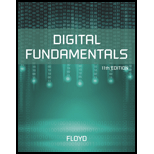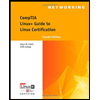
Digital Fundamentals (11th Edition)
11th Edition
ISBN: 9780132737968
Author: Thomas L. Floyd
Publisher: PEARSON
expand_more
expand_more
format_list_bulleted
Textbook Question
Chapter 2, Problem 9TFQ
BCD stands for binary coded decimal
Expert Solution & Answer
Want to see the full answer?
Check out a sample textbook solution
Students have asked these similar questions
Information Security Risk and Vulnerability Assessment
1- Which TCP/IP protocol is used to convert the IP address to the Mac address? Explain 2-What popular switch feature allows you to create communication boundaries between systems connected to the switch3- what types of vulnerability directly related to the programmer of the software?4- Who ensures the entity implements appropriate security controls to protect an asset?
Please do not use AI and add refrence
Find the voltage V0 across the 4K resistor using the mesh method or nodal analysis. Note: I have already simulated it and the value it should give is -1.714V
Resolver por superposicion
Chapter 2 Solutions
Digital Fundamentals (11th Edition)
Ch. 2.1 - Prob. 1CUCh. 2.1 - Prob. 2CUCh. 2.2 - Prob. 1CUCh. 2.2 - Prob. 2CUCh. 2.2 - Prob. 3CUCh. 2.3 - Prob. 1CUCh. 2.3 - Prob. 2CUCh. 2.4 - Prob. 1CUCh. 2.4 - Prob. 2CUCh. 2.4 - Prob. 3CU
Ch. 2.5 - Prob. 1CUCh. 2.5 - Prob. 2CUCh. 2.6 - Prob. 1CUCh. 2.6 - Prob. 2CUCh. 2.6 - Prob. 3CUCh. 2.6 - Prob. 4CUCh. 2.7 - Prob. 1CUCh. 2.7 - Prob. 2CUCh. 2.7 - Prob. 3CUCh. 2.7 - What is the sign of the product when two negative...Ch. 2.7 - Prob. 5CUCh. 2.7 - What is the sign of the quotient when a positive...Ch. 2.7 - Prob. 7CUCh. 2.8 - Prob. 1CUCh. 2.8 - Prob. 2CUCh. 2.8 - Prob. 3CUCh. 2.8 - Prob. 4CUCh. 2.8 - Prob. 5CUCh. 2.8 - Prob. 6CUCh. 2.9 - Prob. 1CUCh. 2.9 - Prob. 2CUCh. 2.9 - Prob. 3CUCh. 2.9 - Prob. 4CUCh. 2.10 - What is the binary weight of each 1 in the...Ch. 2.10 - Convert the following decimal numbers to BCD 6 15...Ch. 2.10 - Prob. 3CUCh. 2.10 - Prob. 4CUCh. 2.11 - Prob. 1CUCh. 2.11 - Prob. 2CUCh. 2.11 - Prob. 3CUCh. 2.12 - Prob. 1CUCh. 2.12 - Prob. 2CUCh. 2.12 - Prob. 3CUCh. 2.12 - Prob. 4CUCh. 2.12 - Prob. 5CUCh. 2 - The decimal number system is a weighted system...Ch. 2 - Prob. 2TFQCh. 2 - Prob. 3TFQCh. 2 - Prob. 4TFQCh. 2 - Prob. 5TFQCh. 2 - Prob. 6TFQCh. 2 - Prob. 7TFQCh. 2 - The hexadecimal number system has 16 characters,...Ch. 2 - BCD stands for binary coded decimalCh. 2 - Prob. 10TFQCh. 2 - Prob. 11TFQCh. 2 - Prob. 12TFQCh. 2 - Prob. 1STCh. 2 - Prob. 2STCh. 2 - Prob. 3STCh. 2 - The decimal number 17 is equal to the binary...Ch. 2 - The decimal number 175 is equal to the binary...Ch. 2 - Prob. 6STCh. 2 - Prob. 7STCh. 2 - Prob. 8STCh. 2 - Prob. 9STCh. 2 - Prob. 10STCh. 2 - Prob. 11STCh. 2 - Prob. 12STCh. 2 - Prob. 13STCh. 2 - Prob. 14STCh. 2 - Prob. 15STCh. 2 - Prob. 16STCh. 2 - Prob. 17STCh. 2 - Prob. 18STCh. 2 - Prob. 19STCh. 2 - Prob. 20STCh. 2 - Prob. 1PCh. 2 - Prob. 2PCh. 2 - Prob. 3PCh. 2 - How high can you count with four decimal digits?Ch. 2 - Prob. 5PCh. 2 - Prob. 6PCh. 2 - Prob. 7PCh. 2 - What is the highest decimal number that can be...Ch. 2 - Prob. 9PCh. 2 - Prob. 10PCh. 2 - Prob. 11PCh. 2 - Prob. 12PCh. 2 - Prob. 13PCh. 2 - Prob. 14PCh. 2 - Prob. 15PCh. 2 - Prob. 16PCh. 2 - Prob. 17PCh. 2 - Prob. 18PCh. 2 - Prob. 19PCh. 2 - Prob. 20PCh. 2 - Prob. 21PCh. 2 - Prob. 22PCh. 2 - Prob. 23PCh. 2 - Prob. 24PCh. 2 - Prob. 25PCh. 2 - Prob. 26PCh. 2 - Prob. 27PCh. 2 - Prob. 28PCh. 2 - Prob. 29PCh. 2 - Prob. 30PCh. 2 - Prob. 31PCh. 2 - Prob. 32PCh. 2 - Prob. 33PCh. 2 - Prob. 34PCh. 2 - Prob. 35PCh. 2 - Prob. 36PCh. 2 - Prob. 37PCh. 2 - Prob. 38PCh. 2 - Convert each hexadecimal number to decimal: 2316...Ch. 2 - Prob. 40PCh. 2 - Prob. 41PCh. 2 - Prob. 42PCh. 2 - Prob. 43PCh. 2 - Prob. 44PCh. 2 - Prob. 45PCh. 2 - Prob. 46PCh. 2 - Prob. 47PCh. 2 - Prob. 48PCh. 2 - Convert the following decimal numbers to BCD: 104...Ch. 2 - Prob. 50PCh. 2 - Convert each of the BCD numbers to decimal...Ch. 2 - Prob. 52PCh. 2 - Prob. 53PCh. 2 - Prob. 54PCh. 2 - In a certain application a 4-bit binary sequence...Ch. 2 - Prob. 56PCh. 2 - Prob. 57PCh. 2 - Prob. 58PCh. 2 - Prob. 59PCh. 2 - Prob. 60PCh. 2 - Prob. 61PCh. 2 - Prob. 62PCh. 2 - Prob. 63PCh. 2 - Prob. 64PCh. 2 - Prob. 65PCh. 2 - Prob. 66PCh. 2 - Prob. 67PCh. 2 - Prob. 68PCh. 2 - Prob. 69P
Additional Engineering Textbook Solutions
Find more solutions based on key concepts
Phone Book Program Design a program that you can use to keep all of your friends names and phone numbers in a f...
Starting Out with Programming Logic and Design (5th Edition) (What's New in Computer Science)
The startsWith, endsWith, and regionMatches methods are members of this class. a. String b. Char c. Character d...
Starting Out with Java: From Control Structures through Data Structures (4th Edition) (What's New in Computer Science)
In Display 12.7 there are two groupings for the unnamed namespace: one for the helping function declarations an...
Problem Solving with C++ (10th Edition)
Assuming that intNumber is an integer variable, what value will each of the following statements assign to it? ...
Starting Out With Visual Basic (8th Edition)
Write an SQL statement to display the name and breed of all pets, sorted by PetName.
Database Concepts (8th Edition)
Complete the following program skeleton so it asks the user to enter a character. Store the character in the va...
Starting Out with C++ from Control Structures to Objects (9th Edition)
Knowledge Booster
Learn more about
Need a deep-dive on the concept behind this application? Look no further. Learn more about this topic, computer-science and related others by exploring similar questions and additional content below.Similar questions
- Describe three (3) Multiplexing techniques common for fiber optic linksarrow_forwardCould you help me to know features of the following concepts: - commercial CA - memory integrity - WMI filterarrow_forwardBriefly describe the issues involved in using ATM technology in Local Area Networksarrow_forward
- For this question you will perform two levels of quicksort on an array containing these numbers: 59 41 61 73 43 57 50 13 96 88 42 77 27 95 32 89 In the first blank, enter the array contents after the top level partition. In the second blank, enter the array contents after one more partition of the left-hand subarray resulting from the first partition. In the third blank, enter the array contents after one more partition of the right-hand subarray resulting from the first partition. Print the numbers with a single space between them. Use the algorithm we covered in class, in which the first element of the subarray is the partition value. Question 1 options: Blank # 1 Blank # 2 Blank # 3arrow_forward1. Transform the E-R diagram into a set of relations. Country_of Agent ID Agent H Holds Is_Reponsible_for Consignment Number $ Value May Contain Consignment Transports Container Destination Ф R Goes Off Container Number Size Vessel Voyage Registry Vessel ID Voyage_ID Tonnagearrow_forwardI want to solve 13.2 using matlab please helparrow_forward
- a) Show a possible trace of the OSPF algorithm for computing the routing table in Router 2 forthis network.b) Show the messages used by RIP to compute routing tables.arrow_forwardusing r language to answer question 4 Question 4: Obtain a 95% standard normal bootstrap confidence interval, a 95% basic bootstrap confidence interval, and a percentile confidence interval for the ρb12 in Question 3.arrow_forwardusing r language to answer question 4. Question 4: Obtain a 95% standard normal bootstrap confidence interval, a 95% basic bootstrap confidence interval, and a percentile confidence interval for the ρb12 in Question 3.arrow_forward
arrow_back_ios
SEE MORE QUESTIONS
arrow_forward_ios
Recommended textbooks for you
 Enhanced Discovering Computers 2017 (Shelly Cashm...Computer ScienceISBN:9781305657458Author:Misty E. Vermaat, Susan L. Sebok, Steven M. Freund, Mark Frydenberg, Jennifer T. CampbellPublisher:Cengage Learning
Enhanced Discovering Computers 2017 (Shelly Cashm...Computer ScienceISBN:9781305657458Author:Misty E. Vermaat, Susan L. Sebok, Steven M. Freund, Mark Frydenberg, Jennifer T. CampbellPublisher:Cengage Learning Systems ArchitectureComputer ScienceISBN:9781305080195Author:Stephen D. BurdPublisher:Cengage LearningNp Ms Office 365/Excel 2016 I NtermedComputer ScienceISBN:9781337508841Author:CareyPublisher:Cengage
Systems ArchitectureComputer ScienceISBN:9781305080195Author:Stephen D. BurdPublisher:Cengage LearningNp Ms Office 365/Excel 2016 I NtermedComputer ScienceISBN:9781337508841Author:CareyPublisher:Cengage- COMPREHENSIVE MICROSOFT OFFICE 365 EXCEComputer ScienceISBN:9780357392676Author:FREUND, StevenPublisher:CENGAGE L
 CompTIA Linux+ Guide to Linux Certification (Mind...Computer ScienceISBN:9781305107168Author:Jason EckertPublisher:Cengage Learning
CompTIA Linux+ Guide to Linux Certification (Mind...Computer ScienceISBN:9781305107168Author:Jason EckertPublisher:Cengage Learning C++ for Engineers and ScientistsComputer ScienceISBN:9781133187844Author:Bronson, Gary J.Publisher:Course Technology Ptr
C++ for Engineers and ScientistsComputer ScienceISBN:9781133187844Author:Bronson, Gary J.Publisher:Course Technology Ptr

Enhanced Discovering Computers 2017 (Shelly Cashm...
Computer Science
ISBN:9781305657458
Author:Misty E. Vermaat, Susan L. Sebok, Steven M. Freund, Mark Frydenberg, Jennifer T. Campbell
Publisher:Cengage Learning

Systems Architecture
Computer Science
ISBN:9781305080195
Author:Stephen D. Burd
Publisher:Cengage Learning

Np Ms Office 365/Excel 2016 I Ntermed
Computer Science
ISBN:9781337508841
Author:Carey
Publisher:Cengage

COMPREHENSIVE MICROSOFT OFFICE 365 EXCE
Computer Science
ISBN:9780357392676
Author:FREUND, Steven
Publisher:CENGAGE L

CompTIA Linux+ Guide to Linux Certification (Mind...
Computer Science
ISBN:9781305107168
Author:Jason Eckert
Publisher:Cengage Learning

C++ for Engineers and Scientists
Computer Science
ISBN:9781133187844
Author:Bronson, Gary J.
Publisher:Course Technology Ptr
Boolean Algebra - Digital Logic and Logic Families - Industrial Electronics; Author: Ekeeda;https://www.youtube.com/watch?v=u7XnJos-_Hs;License: Standard YouTube License, CC-BY
Boolean Algebra 1 – The Laws of Boolean Algebra; Author: Computer Science;https://www.youtube.com/watch?v=EPJf4owqwdA;License: Standard Youtube License